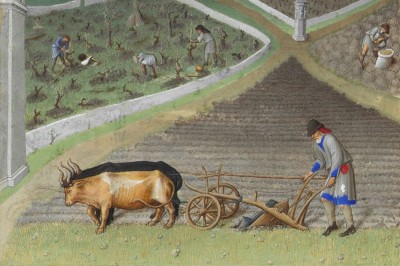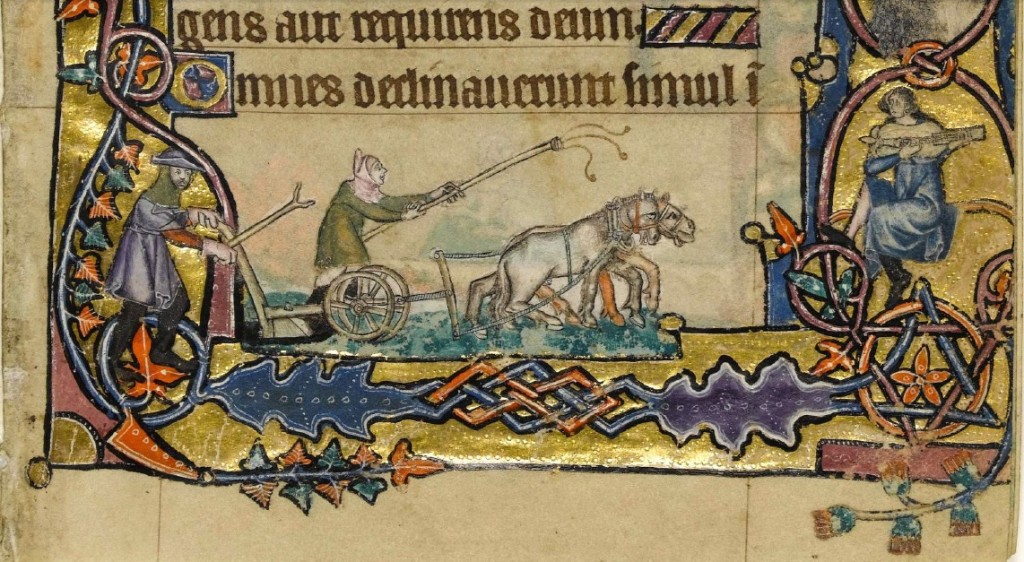New research proves beyond doubt the importance of the heavy plough for economic development between AD 900 -1300.
In 1962 Lynn White, Jr. argued – against all the Marxists – that the primary explanation for the economic and demographic boom around AD 1000 was the introduction of the heavy mouldboard plough. As opposed to the traditional and ancient ard, the plough, with its mouldboard, share and coulter, was able to cut through the clay soils of Northern and Central Europe. Thus the introduction of the plough – according to White – made extensive cultivation of the Northern and Eastern wilderness possible.
Further, in terms of the size of the harvest, the plough – in contrast to the ard – not only turns the soil and buries the weed. The plough also brings the lower soil, where the nutrients have been trapped, to the surface.
Finally, this gradual introduction of the plough was believed by White to have a series of other consequences. Primarily it caused an increased need for oxen or horses, thus indirectly causing a need for fodder crops; hence the transition from infield-outfield farming to the open-field system and a more systematic crop rotation. Finally, it was claimed to cause an increased need for peasant collaboration primarily in connection with the caretaking of the draught beasts and the need to fence in the fields during the season of growth.
 Needless to say, Lynn White’s work was not well received in the 60’s and 70’s research climate. Thus in a scathing review in Past and Present (vol 24), the Marxist Rodney H. Hilton went ballistic in his critique of the sources and literature upon which Lynn White based his arguments .
Needless to say, Lynn White’s work was not well received in the 60’s and 70’s research climate. Thus in a scathing review in Past and Present (vol 24), the Marxist Rodney H. Hilton went ballistic in his critique of the sources and literature upon which Lynn White based his arguments .
The new work, which a research collaborative has carried out at The University of Odense in Denmark, is based on a correlation of a number of different parameters. Apparently it seems to redeem the writings of Lynn White.
Using GIS the researchers have identified the regional localities in Europe with fertile clay soil. Secondly, these areas’ degree of urbanization and demographic density have been decided based on the historical series at EurAtlas. Thirdly the researchers have controlled for the effects of such phenomena as trade possibilities, markets and Roman Heritage.
Correlating these types of information show overwhelmingly that there is a correlation between the growth of population density and urbanization – and not least how this correlation can be traced back to the period between AD 900 – 1000.
It stands to reason that the researchers do not conclude that the introduction of the plough univocally caused the growth in terms of demographics and urbanization in this period.” Our results are silent on how such innovations as the new harness and the three field rotational system affected the plough”, writes Christian Skovsgaard in a preliminary publication. Nevertheless, the results seem statistically very sound. Thus to some extent redeeming Lynn White and his thesis.
READ ABOUT THE PROJECT:
The Heavy Plough and the European Agricultural Revolution of the Middle Ages.
How the heavy plough changed the world. In Science Nordic, 22.01.2013
READ MORE
Medieval Technology and Social Change.
By Lynn White, Jr.
Oxford University Press 1962/1966
One of the critiques of Rodney H. Hilton was the claim by White, that the Danes introduced the plough and the coulter to England. However, since then, archaeology has to some extent redeemed this proposition. See the story about a find of a coulter in Lyminge in Kent.


